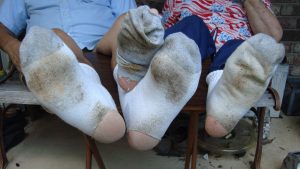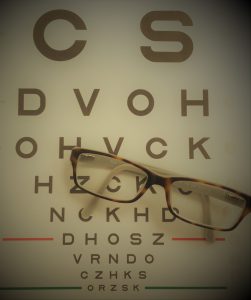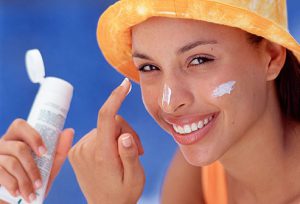
by Melanie Taylor | Oct 16, 2017

Make Halloween a fun and safe night for children and adults alike.
From candy to pumpkins to the costumes, Halloween is a fun-filled time for kids and adults alike. However, it can pose dangers. To help make this year’s trick-or-treat a safe and fun time, follow these simple safety tips compiled by the American Academy of Pediatrics.
CREATIVE COSTUMES:
Plan costumes that are bright and reflective. Make sure shoes fit well and costumes are short enough to prevent tripping, entanglement, or contact with flames.
Consider adding reflective tape or striping to costumes and trick-or-treat bags for greater visibility.
Because masks can limit or block eyesight, consider non-toxic makeup and decorative hats as safer alternatives. Hats should fit properly to prevent them from sliding over eyes. The makeup should be tested on a small patch of skin ahead of time to ensure there are no unpleasant allergies on the big night.
When shopping for costumes, wigs, and accessories, look for and purchase those with a label clearly indicating they are “flame resistant.”
If a sword, cane, or stick is a part of your child’s costume, make sure it is not sharp or long. A child may be easily hurt by the accessories if he/she stumbles or trips.
Do not use decorative contact lenses without an eye examination and a prescription from an eye care professional. While the packaging on decorative lenses will often make claims such as “one size fits all,” or “no need to see an eye specialist,” obtaining decorative contact lenses without a prescription is both dangerous and illegal. This can cause pain, inflammation, and serious eye disorders and infections, which may lead to permanent vision loss.
Review with children how to call 911 if they ever have an emergency or become lost.
PUMPKIN CARVING TIME:
Small children should never carve pumpkins. Children can draw a face with markers. Then adults can do the cutting.
Consider using a flashlight or glow stick instead of a candle to light your pumpkin. If you do use a candle, a votive candle is safest.
Candlelit pumpkins should be placed on a sturdy table, away from curtains and other flammable objects, and not on a porch or any path where visitors may pass close by. They should never be left unattended.
HOME SAFETY:
To keep homes safe for visiting trick-or-treaters, parents should remove from the porch and front yard anything a child could trip over such as garden hoses, toys, bikes, and lawn decorations.
Adults should check outdoor lights and replace burned-out bulbs.
Wet leaves and debris should be swept from sidewalks and steps.
Restrain pets so they do not jump on or bite a trick-or-treater.
TRICK-OR-TREAT TIME:
A responsible adult should always accompany young children during their neighborhood trick-or-treating.
Obtain flashlights with fresh batteries for all children and adults.
If your older children are going alone, plan and review the route that is acceptable to you. Agree on a specific time when they should return home.
Only go to homes with a porch light on and never enter a home or car for a treat.
Because pedestrian injuries are the most common injuries to children on Halloween, remind Trick-or-Treaters to:
- Stay in a group and communicate where they will be going.
- Remember reflective tape for costumes and trick-or-treat bags.
- Carry a cellphone for quick communication.
- Remain on well-lit streets and always use the sidewalk.
- If no sidewalk is available, walk at the far edge of the roadway facing traffic.
- Never cut across yards or use alleys.
- Only cross the street as a group in established crosswalks (as recognized by local custom). Never cross between parked cars or out of driveways.
- Do not assume the right of way. Motorists may have a hard time seeing Trick-or-Treaters.
- Just because one car stops does not mean others will!
- Law enforcement authorities should be notified immediately of any suspicious or unlawful activity.
HEALTHY HALLOWEEN TIPS:
A good, healthy dinner prior to parties and trick-or-treating will discourage children from filling up on Halloween treats.
Consider purchasing non-food treats for those who visit your home, such as coloring books, stickers, or pens and pencils.
Wait until children are home to sort and check treats. Though tampering is rare, a responsible adult should closely examine all treats and throw away any spoiled, unwrapped or suspicious items.
Try to ration treats for the days and weeks following Halloween to prevent overindulging, which will lead to a stomachache and ruin the night’s fun.
Make sure the Halloween night is fun and safe with the suggested tips above. These tips will help guarantee you all a ghoulishly good time.
Source: American Academy of Pediatrics

by Angela Hinkle | Aug 24, 2017
 What’s worse than wearing wet socks? Okay – wet, dirty socks. Or wet, dirty socks with holes. Ooh, ooh, the worst – cold, wet, dirty socks with holes.
What’s worse than wearing wet socks? Okay – wet, dirty socks. Or wet, dirty socks with holes. Ooh, ooh, the worst – cold, wet, dirty socks with holes.
If your feet are in clean, dry socks with no need of mending, think for a moment about those not so lucky.
Homeless shelters are continuously in need of new socks. If you’re homeless, you walk – a lot. Many homeless walk several miles every day for food, shelter, and other essentials. Getting the assistance you need is easier when your feet are healthy and don’t have blisters. People are often more motivated to seek employment and keep it when they feel confident in the way they look. Wearing socks and shoes with holes decreases their sense of self-worth. A clean set of socks is often the first step in restoring their feeling of dignity.
Wet socks breed bacteria, which can cause infection. And since more than a million Americans have diabetes, wearing cold, wet, holey, dirty socks puts them at greater risk of skin injuries and infections. According to WebMD, diabetics should never walk barefoot and should wear comfortable socks and shoes that fit well and protect the feet. For more foot care tips, see Tips on Good Foot Care.
If you like keeping things local, know that cotton is considered a power crop in the panhandle of Florida. It’s rotated in alternate years with peanuts to avoid pests, diseases, and weeds. Some socks are 100% cotton; many are a blend of cotton mixed with other fibers.
So, help the local economy in the Florida Panhandle and help someone by giving them socks. Buy new socks with cotton. Keep a pair for yourself and donate some to a homeless shelter near you. (Waterfront Mission is a great place to start – Waterfront Mission Donations.) You’ll feel better and so will they.
by Amy Mullins, PhD, RDN | Aug 24, 2017
 It’s something we all hopefully learned as children and carry with us now into adulthood: washing our hands often and properly. But I’m sorry to say that we’ve probably all witnessed numerous instances of people leaving the restroom, coughing or sneezing, touching their cell phones or any number of other filthy surfaces, and then neglecting to wash their hands. According to a research study from Michigan State University (2013), only 5% of people washed their hands properly after using the toilet with 7% of men and 15% of women not washing their hands at all. This type of behavior is a recipe for disaster, leading to the spread of germs and pathogens.
It’s something we all hopefully learned as children and carry with us now into adulthood: washing our hands often and properly. But I’m sorry to say that we’ve probably all witnessed numerous instances of people leaving the restroom, coughing or sneezing, touching their cell phones or any number of other filthy surfaces, and then neglecting to wash their hands. According to a research study from Michigan State University (2013), only 5% of people washed their hands properly after using the toilet with 7% of men and 15% of women not washing their hands at all. This type of behavior is a recipe for disaster, leading to the spread of germs and pathogens.
Germs and pathogens are invisible and ubiquitous, living on every imaginable surface. Even though they can’t be seen by the naked eye they have the ability to make us very sick, and can even be deadly. According to Dr. Charles Gerba, a microbiologist with the University of Arizona, a typical cell phone has approximately 25,000 germs per square inch! We spread germs very easily from surface to surface and from hand to mouth, increasing the potential for illness to ourselves and others every step of the way. If these germs contaminate food contact surfaces or the food we eat, the likelihood for a foodborne illness has been created. Common symptoms of foodborne illness include diarrhea, vomiting, nausea, and abdominal cramps. The Centers for Disease Control and Prevention (CDC) estimates that each year roughly 1 in 6 Americans (or 48 million people) gets sick, 128,000 are hospitalized, and 3,000 die of foodborne diseases.
The good news is that we all have the power to stop the spread of germs. The Food and Drug Administration says that “washing with plain soap and running water remains one of the most important steps consumers can take to avoid getting sick and to prevent spreading germs to others.”
It’s good practice to always wash your hands (CDC):
- Before, during, and after preparing food
- Before eating food
- Before and after caring for someone who is sick
- Before and after treating a cut or wound
- After using the toilet
- After changing diapers or cleaning up a child who has used the toilet
- After blowing your nose, coughing, or sneezing
- After touching an animal, animal feed, or animal waste
- After handling pet food or pet treats
- After touching garbage
Are you following these steps to proper handwashing (CDC)?
- Wet your hands with clean, running water (warm or cold), turn off the tap, and apply soap.
- Lather your hands by rubbing them together with the soap. Be sure to lather the backs of your hands, between your fingers, and under your nails.
- Scrub your hands for at least 20 seconds. Need a timer? Hum the “Happy Birthday” song from beginning to end twice.
- Rinse your hands well under clean, running water.
- Dry your hands using a clean towel or air dry them.
Soap and water may not always be available, so using hand sanitizer is the next best thing. Although hand sanitizers don’t kill all germs, the CDC recommends choosing a sanitizer with at least 60% alcohol to significantly reduce the number of germs and pathogens on your hands.
For more information on handwashing and hand sanitizers refer to the CDC Handwashing Factsheet. Additional information about foodborne illnesses and the pathogens that cause them can be found at https://www.cdc.gov/foodsafety/foodborne-germs.html
by Melanie Taylor | Aug 5, 2017

Most of us are willing to go to the doctor or the dentist, which are both part of taking care of our health. However, do you go to the eye doctor? If not, you definitely should add it to your healthy lifestyle regime. Eye exams at every age and stage of life can help you keep your vision strong. August is National Eye Exam month; this is the perfect reminder to schedule a comprehensive eye exam.
The Vision Council of America reports that 12.2 million Americans require some sort of vision correction, but do not use any. Nearly 50% of parents with children under 12 have never taken their children to an eye-care professional.
Many people think their eyesight is just fine, but then they get that first pair of glasses or contact lenses and the world becomes much clearer – everything from fine print to street signs. Improving and/or maintaining your eyesight is important – about 11 million Americans over age 12 need vision correction, but that is just one of the reasons to get your eyes examined. Regular eye exams are also an important part of finding eye diseases early and preserving your vision.
Eye diseases are common and can go unnoticed for a long time. Some diseases have no symptoms at first. A comprehensive dilated eye exam by an optometrist (a medical professional with a focus on regular vision care who can prescribe eyeglasses and contacts) or ophthalmologist (a medical eye doctor with a focus on the complete eye health) is necessary to find eye diseases in the early stages when treatment to prevent vision loss is most effective. During the exam, visual acuity (sharpness), depth perception, eye alignment, and eye movement are tested. Eye drops are used to make your pupils larger so your eye doctor can see inside your eyes and check for signs of health problems.
How often should you have an eye exam?
- A child’s eyes should be checked regularly by an eye doctor or pediatrician. The U.S. Preventive Services Task Force recommends vision screening for all children at least once between age 3 and 5 years to detect amblyopia or risk factors for the disease. Amblyopia is when the vision in one of the eyes is reduced because the eye and the brain are not working together properly. The eye itself looks normal, but it is not being used normally because the brain is favoring the other eye. This condition is sometimes called lazy eye.
- People with diabetes should have a dilated eye exam every year.
- People with a family history of glaucoma should have an eye exam every year.
- Adults with good health should have an eye exam at least every 2 years.
Some people are at higher risk for glaucoma and should have a dilated eye exam every 1 to 2 years:
- African Americans, ages 40 years and older.
- Everyone older than age 60, especially Mexican Americans.
- People with a family history of glaucoma.
Early treatment is critically important to prevent some common eye diseases from causing permanent vision loss or blindness:
- Cataracts (clouding of the lens), the leading cause of vision loss in the United States.
- Diabetic retinopathy (causes damage to blood vessels in the back of the eye), the leading cause of blindness in American adults.
- Glaucoma (a group of diseases that damages the optic nerve).
- Age-related macular degeneration (gradual breakdown of light-sensitive tissue in the eye).
Other reasons to see your eye doctor: If you have any of the following eye problems, do not wait for your next appointment, schedule your eye appointment as soon as possible:
- Decreased vision
- Draining or redness of the eye
- Eye pain
- Double vision
- Diabetes
- Floaters (tiny specks that appear to float before your eyes)
- Halos around lights
- Flashes of light.
Center for Disease Control and Prevention (CDC) 10 Tips to Protect Your Vision:
- Get a regular comprehensive dilated eye exam.
- Know your family’s eye health history.
- Eat right to protect your sight. You have heard that carrots are good for your eyes. But eating a diet rich in fruits and vegetables—particularly dark leafy greens, such as spinach, kale, or collard greens—is important for keeping your eyes healthy, too.
- Maintain a healthy weight.
- Wear protective eyewear when playing sports or doing activities around the home. Protective eyewear includes safety glasses and goggles, safety shields, and eye guards specially designed to provide the correct protection.
- Be cool and wear your shades. Wear sunglasses that block out 99% to 100% of UV-A and UV-B radiation (the sun’s rays).
- Give your eyes a rest. If you spend a lot of time at the computer or focusing on any one thing, you sometimes forget to blink and your eyes can get fatigued. Try the 20-20-20 rule: Every 20 minutes, look away about 20 feet in front of you for 20 seconds. This short exercise can help reduce eyestrain.
- Clean your hands and your contact lenses properly.
- Practice workplace eye safety.
- Quit smoking or never start.
Of the estimated 61 million US adults at high risk for vision loss, only half visited an eye doctor last year. Regular eye care can have a life-changing impact on preserving the vision of millions of people. Be sure to make your eye health a priority in your life. Healthy eyes lead to better vision and an overall better quality of life. Sources: Vision Council of America https://www.thevisioncouncil.org/ Center for Disease Control and Prevention https://www.cdc.gov/
by jbreslawski | Jun 11, 2016
 In Florida, we are so lucky to have access to beautiful beaches and weather. There are an infinite number of outdoor activities to do. This past week I tried a new one for me, SUP (Stand Up Paddle boarding). I fell a few times, but finally found my balance and had a blast all day long. Things changed though when the fun was over and I realized that I forgot to wear a hat and had a blistering burn on my scalp. According to the Center for disease control the sun can burn unprotected skin in as little as 15 minutes. In order to protect yourself from the sun be sure to apply and reapply sunscreen (at least SPF 15) regularly, stay in the shade, wear a hat and UV protective sunglasses, when possible protective clothing such as long sleeved shirts and pants, and limit time outdoors in peak sun hours of 10am-4pm.
In Florida, we are so lucky to have access to beautiful beaches and weather. There are an infinite number of outdoor activities to do. This past week I tried a new one for me, SUP (Stand Up Paddle boarding). I fell a few times, but finally found my balance and had a blast all day long. Things changed though when the fun was over and I realized that I forgot to wear a hat and had a blistering burn on my scalp. According to the Center for disease control the sun can burn unprotected skin in as little as 15 minutes. In order to protect yourself from the sun be sure to apply and reapply sunscreen (at least SPF 15) regularly, stay in the shade, wear a hat and UV protective sunglasses, when possible protective clothing such as long sleeved shirts and pants, and limit time outdoors in peak sun hours of 10am-4pm.
Oh, so you don’t need to because you tan? Well think again. esides leaving you with an awful burn, blisters and flakey skin, sitting out in the sun can cause lines and wrinkles, sun-spots, and increase your chance of skin cancer. The American Cancer Society is estimating 6,200 new cases of skin cancer, this year, in Florida alone. Most of these cases can be linked to too much sun exposure. Regular sun protection can reduce the risk of developing skin cancer; regular dermatologist skin checks and self-exams can help identify cases early. The Skin Cancer Foundation, recommends keeping watch for individual moles that are misshapen, have uneven borders, a variety of colors, a diameter of over ¼”, or have changed in any of these features. This summer have fun, live in the moment, try something new, but don’t forget your SPF.







